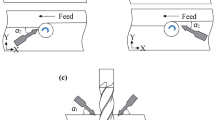Abstract
The main focus of this work is the effect of the third body on the friction coefficient of the bottom edge tool chip in spiral milling with internal cooling at high speeds. The maximum pressure of the tool-chip contact and the tool-chip friction factor of the bottom edge are estimated by evaluating the helical milling principle and milling experiments. Moreover, the Hertz-Mindlin with bonding discrete element model (DEM) is established and corrected. According to the discrete element model and the morphology of the machined surface and the bottom edge, the friction coefficient of the bottom edge tool chip in high-speed internal cooling milling decreases with an increase in third bodies. The bottom edge’s friction coefficient is lowered by adding third-body particles. The third body increases with spindle speed but decreases with increased pitch. The research results provide a reference for studying tool-chip friction coefficient in high-speed internal cooling helical milling.













Similar content being viewed by others
Data availability
Not applicable.
Code availability
Not applicable.
References
Shi M, Qin X, Li H, Shang S, Jin Y, Huang T (2020) Cutting force and chatter stability analysis for PKM-based helical milling operation. Int J Adv Manuf Technol 111:3207–24
Su C, ChengCA X, Yan X, Zheng G, Li Y, Mu Z (2022) Helical milling for making holes on carbon fiber-reinforced polymer. Int J Adv Manuf Technol 121(7–8):5197–205
Denkena B, Boehnke D, Dege JH (2008) Helical milling of CFRP–titanium layer compounds. CIRP J Manuf Sci Technol 1(2):64–9
Akmal M, Ehsan Layegh KS, Lazoglu I, Akgün A, Yavas C (2017) Friction Coefficients on Surface Finish of AlTiN Coated Tools in the Milling of Ti6Al4V. Procedia CIRP 58:596–600
Saito Y, Yamaguchi T, Itagaki R (2017) Effect of coefficient of friction at the sliding zone of chip-tool interface on chip curl diameter and secondary shear zone thickness during tapping process. J Adv Mech Des Syst Manuf 11(1):JAMDSM0007
Wang H, Zhang T, Wang S, To S (2020) Characterization of the friction coefficient of aluminum alloy 6061 in ultra-precision machining. Metals 10(3):336
Goryacheva I, Meshcheryakova A (2022) Modelling of third body effect on rolling contact fatigue damage. Mech Res Commun 123:103901
Hu J, Yuan F, Liu X, Wei Y (2021) Effect of plasticity on nanoscale wear of third-body particles. Tribol Int 155:106739
Han X, Yang J, Nong W (2020) Tribological Behavior of Copper and Graphite of Layered Friction Materials. Tribol Trans 63(5):906–912
Yang S, Yang Y, Zhou L, Zhan R, Man Y (2022) Intermediate-layer Transferable Adversarial Attack with DNN Attention. IEEE Access 10:95451–95461
Feng C, Wang Y, Chen W, Zhang L, Zhou K (2017) The Mechanical Mixed Layer and Its Role in Cu-15Ni-8Sn/Graphite Composites. Tribol Trans 60(1):135–145
Wu S, Bi J, Li Z, Liao H, Wang C, Zheng L (2020) Feasibility study of oil-on-water cooling in high-speed end milling of hardened steel. Int J Adv Manuf Technol 107(1–2):271–92
Nouari M, Iordanoff I (2007) Effect of the third-body particles on the tool-chip contact and tool-wear behaviour during dry cutting of aeronautical titanium alloys. Tribol Int 40(9):1351–9
von Lautz J, Pastewka L, Gumbsch P, Moseler M (2016) Molecular Dynamic Simulation of Collision-Induced Third-Body Formation in Hydrogen-Free Diamond-Like Carbon Asperities. Tribol Lett 63(2):26
Mogonye JE, Srivastava A, Gopagoni S, Banerjee R, Scharf TW (2016) Solid/Self-Lubrication Mechanisms of an Additively Manufactured Ni–Ti–C Metal Matrix Composite. Tribol Lett 64(3):1–12
Renouf M, Cao H-P, Nhu V-H (2011) Multiphysical modeling of third-body rheology. Tribol Int 44(4):417–25
Wang W, Liu X, Liu K, Xiong Q (2012) DEM Simulation on Tribological Behaviour of Third-Body Interface with Different Shear Elastic Modulus. Adv Compos Mater 482:1951–4
Yang W, Wang M, Zhou Z, Li L, Yang G, Ding R (2020) Research on the relationship between macroscopic and mesoscopic mechanical parameters of limestone based on Hertz Mindlin with bonding model. Geomech Geophys Geo-Energy Geo-Resour 6:1–15
Du M, Cheng Z, Wang S (2019) Finite element modeling of friction at the tool-chip-workpiece interface in high speed machining of Ti6Al4V. Int J Mech Sci 163:105100
Mollon G (2022) The soft discrete element method. Granul Matter 24(1):11
Yu AB (2004) Discrete element method: An effective way for particle scale research of particulate matter. Eng Comput 21(2–4):205–214
Xiao S-Y, Su L-J, Jiang Y-J (2019) Numerical investigation on flexible barriers impacted by dry granular flows using DEM modeling. Chin J Geotech Eng 41(3):526–533
Funding
This study received financial support from the National Natural Science Foundation of China under Grant No. 51375099, 2022 Project of Guangdong Provincial Finance Department (Overseas famous teacher) under Grant No. K22322, and the scientific research start-up funds of Guangdong Ocean University under Grant No. E15168.
Author information
Authors and Affiliations
Contributions
The study’s conception and design were performed by Jingyue Wu and Ningxia Yin. All authors contributed to material preparation, data collection, and analysis. The first draft of the manuscript was written by Jingyue Wu, and Ningxia Yin commented on previous versions of the manuscript. All authors read and approved the final manuscript.
Corresponding author
Ethics declarations
Ethics approval
Not applicable.
Consent to participate
Not applicable.
Consent for publication
All of the authors mentioned in the manuscript have agreed to authorship, read, and approved the manuscript, and give consent for submission and subsequent publication of the manuscript.
Conflict of interest
The authors declare no competing interests.
Additional information
Publisher's Note
Springer Nature remains neutral with regard to jurisdictional claims in published maps and institutional affiliations.
Rights and permissions
Springer Nature or its licensor (e.g. a society or other partner) holds exclusive rights to this article under a publishing agreement with the author(s) or other rightsholder(s); author self-archiving of the accepted manuscript version of this article is solely governed by the terms of such publishing agreement and applicable law.
About this article
Cite this article
Wu, J., Yin, N., Lv, L. et al. Study on the tool-chip friction coefficient of the bottom edge in high-speed internal cooling spiral milling hole. Int J Adv Manuf Technol 131, 369–380 (2024). https://doi.org/10.1007/s00170-024-13109-6
Received:
Accepted:
Published:
Issue Date:
DOI: https://doi.org/10.1007/s00170-024-13109-6



